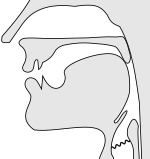Voiced uvular plosive
This articleneeds additional citations forverification.(July 2015) |
| Voiced uvular plosive | |||
|---|---|---|---|
| ɢ | |||
| IPA Number | 112 | ||
| Audio sample | |||
| Encoding | |||
| Entity(decimal) | ɢ | ||
| Unicode(hex) | U+0262 | ||
| X-SAMPA | G\ | ||
| Braille | |||
| |||
Thevoiced uvular plosiveorstopis a type ofconsonantalsound, used in somespokenlanguages.The symbol in theInternational Phonetic Alphabetthat represents this sound is ⟨ɢ⟩, asmall capitalversion of the Latin letterg,and the equivalentX-SAMPAsymbol isG\.
[ɢ]is a rare sound, even compared to other uvulars.[1]Vaux proposes a phonological explanation: uvular consonants normally involve a neutral or aretracted tongue root,whereas voiced stops often involve anadvanced tongue root:two articulations that cannot physically co-occur. This leads many languages of the world to have avoiced uvular fricative[ʁ]instead as the voiced counterpart of thevoiceless uvular plosive.Examples areInuit;severalTurkic languagessuch asUyghurandYakut;severalNorthwest Caucasian languagessuch asAbkhaz;severalMongolic languagessuch asMongolianandKalmyk,as well as severalNortheast Caucasian languagessuch asIngush.
There is also thevoiced pre-uvular plosive[2]in some languages, which is articulated slightly more front compared with the place of articulation of the prototypical uvular plosive, though not as front as the prototypicalvelar plosive.The International Phonetic Alphabet does not have a separate symbol for that sound, though it can be transcribed as ⟨ɢ̟⟩ (advanced⟨ɢ⟩), ⟨ɡ̠⟩ or ⟨ɡ˗⟩ (both symbols denote aretracted⟨ɡ⟩). The equivalent X-SAMPA symbols areG\_+andg_-,respectively.
Features[edit]
Features of the voiced uvular stop:
- Itsmanner of articulationisocclusive,which means it is produced by obstructing airflow in the vocal tract. Since the consonant is also oral, with nonasal outlet,the airflow is blocked entirely, and the consonant is aplosive.
- Itsplace of articulationisuvular,which means it is articulated with the back of thetongue(the dorsum) at theuvula.
- Itsphonationis voiced, which means the vocal cords vibrate during the articulation.
- It is anoral consonant,which means air is allowed to escape through the mouth only.
- It is acentral consonant,which means it is produced by directing the airstream along the center of the tongue, rather than to the sides.
- Theairstream mechanismispulmonic,which means it is articulated by pushing air solely with theintercostal musclesandabdominal muscles,as in most sounds.
Occurrence[edit]
| Family | Language | Word | IPA | Meaning | Notes | |
|---|---|---|---|---|---|---|
| Semitic | Arabic | Sudanese | بقرة | [bɑɢɑrɑ] | 'cow' | Corresponds to/q/inStandard Arabic.SeeArabic phonology |
| Yemeni[3] | قات | 'Khat' | Some dialects.[3]Corresponds to/q/inStandard Arabic.SeeArabic phonology | |||
| Germanic | English | Australian[4] | gaudy | [ˈɡ̠oːɾi] | 'gaudy' | Pre-uvular; allophone of/ɡ/before/ʊoːɔoɪʊə/.[4]SeeAustralian English phonology |
| Yeniseian | Ket[5] | báŋquk | [baŋ˩˧ɢuk˧˩] | 'cave in the ground' |
Allophone of/q/after/ŋ/.[5] | |
| Wakashan | Kwak'wala | ǥilakas'la | [ɢilakasʔla] | 'thank you' | ||
| Semitic | Lishan Didan | Urmi Dialect | בקא/baqqa | [baɢːɑ] | 'frog' | Allophone of/q/when between a vowel/sonorant and a vowel. |
| Dravidian | Malto | तेंग़े | [t̪eɴɢe] | 'to tell' | Allophone of/ʁ/after/ŋ/,/ʁ,ŋʁ/is/h/in Southern and Western dialects. | |
| Mongolic | Mongolian | Монгол ᠮᠣᠩᠭᠣᠯ |
[mɔɴɢɔ̆ɮ] | 'Mongolian' | Allophone of/g/before back vowels, phonemic word-finally. | |
| Isolate | Nivkh | ньыӈӷан | [ɲɤŋɢæn] | 'our dog' | Allophone of/q/ | |
| Indo-Iranian | Persian | Iranian | قهوه | [ɢæhˈve] | 'coffee' | SeePersian phonology. |
| Cushitic | Somali | Muqdisho | [muɢdiʃɔ] | 'Mogadishu' | Allophone of/q/.SeeSomali phonology | |
| Northeast Caucasian | Tabasaran | дугу | [d̪uɢu] | 'he' (ergative) | ||
| Na-Dene | Tlingit | ghooch | [ɢuːt͡ʃʰ] | 'hill' | Among some younger speakers, for standard[quːt͡ʃʰ].SeeTlingit phonology | |
| Northeast Caucasian | Tsakhur | къгяйэ | [ɢajɛ] | 'stone' | ||
| Turkic | Turkmen | gar | [ɢɑɾ] | 'snow' | An allophone of /ɡ/ next to back vowels | |
| Qiangic | Xumi | Lower[6] | [ɢʶo˩˥] | 'to stew' | Slightly affricated; occurs only in a few words.[7]Corresponds to the cluster/Nɡ/in Upper Xumi.[8] | |
| Pama-Nyungan | Yanyuwa[9] | kuykurlu | [ɡ̠uɡ̟uɭu] | 'sacred' | Pre-uvular.[9]Contrasts plain andprenasalizedversions | |
See also[edit]
Notes[edit]
- ^Vaux (1999).
- ^Instead of "pre-uvular", it can be called "advanced uvular", "fronted uvular", "post-velar", "retracted velar" or "backed velar". For simplicity, this article uses only the term "pre-uvular".
- ^abWatson (2002),p. 13.
- ^abMannell, Cox & Harrington (2009).
- ^abGeorg (2007),pp. 49, 67 and 77.
- ^Chirkova & Chen (2013),p. 365.
- ^Chirkova & Chen (2013),pp. 365–366.
- ^Chirkova, Chen & Kocjančič Antolík (2013),pp. 383, 387.
- ^abLadefoged & Maddieson (1996),pp. 34–35.
References[edit]
- Chirkova, Katia; Chen, Yiya (2013)."Xumi, Part 1: Lower Xumi, the Variety of the Lower and Middle Reaches of the Shuiluo River"(PDF).Journal of the International Phonetic Association.43(3): 363–379.doi:10.1017/S0025100313000157.JSTOR26347850.Archived fromthe original(PDF)on 2017-05-07.
- Chirkova, Katia; Chen, Yiya; Kocjančič Antolík, Tanja (2013)."Xumi, Part 2: Upper Xumi, the Variety of the Upper Reaches of the Shuiluo River"(PDF).Journal of the International Phonetic Association.43(3): 381–396.doi:10.1017/S0025100313000169.Archived fromthe original(PDF)on 2020-04-23.
- Georg, Stefan (2007).A Descriptive Grammar of Ket (Yenisei-Ostyak).Languages of Asia. Vol. 1. Brill. p. 78.doi:10.1163/ej.9781901903584.i-328.ISBN978-90-04-21350-0.
- Ladefoged, Peter;Maddieson, Ian(1996),The Sounds of the World's Languages,Oxford: Blackwell,ISBN0-631-19815-6
- Mannell, R.; Cox, F.; Harrington, J. (2009)."Phonetic (Narrow) Transcription of Australian English".An Introduction to Phonetics and Phonology.Macquarie University. Archived fromthe originalon 2012-03-25.
- Watson, Janet C. E. (2002).The Phonology and Morphology of Arabic.The Phonology of the World's Languages. New York: Oxford University Press.ISBN9780199257591.
- Vaux, Bert (December 2001) [orig. pub. 1999, Harvard Working Papers in Linguistics, vol. 7].A Note on Pharyngeal Features(Report). Version 2.



